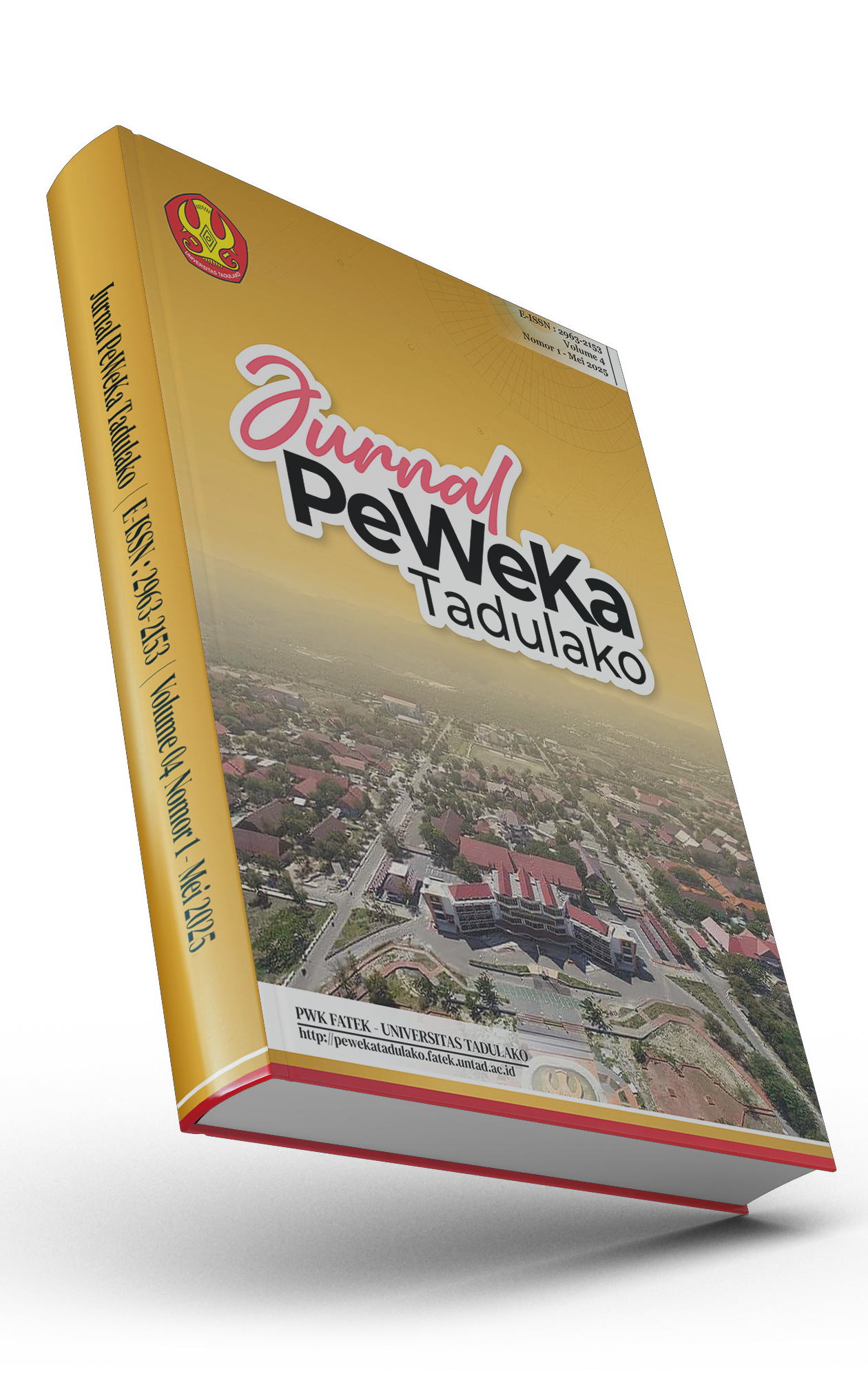Perubahan Morfologi Sungai Lariang: Analisis Spasiotemporal dengan Pendekatan Penginderaan Jauh
DOI:
https://doi.org/10.22487/peweka.v4i1.53Keywords:
River Change, Lariang, Spasiotemporal, Erosion, AcretionAbstract
Rivers are one of the natural elements that play an important role in the ecosystem, both in terms of water supply, agricultural irrigation, and supporting biodiversity.The continuously changing morphology of the river needs to be monitored periodically to understand the dynamics of changes and their impact on the environment.This study aims to identify the dynamics of morphological changes in the lower reaches of the Lariang River based on river erosion and deposition over a 10-year period.The method used is spatiotemporal analysis of river erosion and deposition patterns in 2013, 2018, and 2023. The analysis was conducted through the interpretation of Google Earth Pro satellite imagery, which was then digitized using ArcGIS software.The research results indicate that there are significant dynamics in the river meanders at several points, especially in segments with sharp bends.During the period 2013-2018, the area of erosion was 971,298 m², while the area of accretion was 1,624,959 m².In the period 2018-2023, the area of erosion was 644,619 m², while the area of accretion was 981,088 m².The high dynamics of erosion and accretion cause river deflection and the formation of new landforms.
References
Andiese, V. W., & Setiawan, A. (2012). Normalisasi Sungai Lariang Berdasarkan Aspek Guna Lahan. Infrastruktur, 2(2), 242687.
Ambarwati, R., & Patandean, A. J. (2019). Evaluasi Perubahan Perilaku Erosi Daerah Aliran Sungai Rammang-rammang dengan Pemodelan Spasial. Jurnal Sains dan Pendidikan Fisika, 14(1), 319180.
Chang, H.H. (2008). River morphology and river channel changes. Transactions of Tianjin University, 14, 254–262. https://doi.org/10.1007/s12209-008-0045-3
Dehkordi, A. K., Nafchi, R. F., Samadi-Boroujeni, H., Boroujeni, M. K., & Ostad–Ali–Askari, K. (2024). Assessment of morphological changes of river bank erosion using landsat satellite time-series images. Ain Shams Engineering Journal, 15(3), 102455.
Ferdowsi, B., Ortiz, C. P., Houssais, M., & Jerolmack, D. J. (2017). River-bed armouring as a granular segregation phenomenon. Nature communications, 8(1), 1363.
Ghosh, B. (2024). Assessing the effects of human interventions on the morphodynamics and health of a lowland tropical river: A case study of the river Dwarkeswar, India. Geosystems and Geoenvironment, 3(1), 100234.
Grabowski, R. C., Surian, N., & Gurnell, A. M. (2014). Characterizing geomorphological change to support sustainable river restoration and management. WIREs Water, 1(4), 329-349.
Hossain, M. A., Gan, T. Y., & Baki, A. B. M. (2013). Assessing morphological changes of the Ganges River using satellite images. Quaternary international, 304, 142-155.
Knighton, D. (1998). Fluvial forms and processes: A new perspective. Oxford University Press.
Kotluri, S. K., Pandey, P., & Pandey, A. K. (2024). A Google Earth and ArcGIS-based protocol for channel width extraction. Journal of Earth System Science, 133(1), 9.
Kumar, S. S., Pandey, M., & Shukla, A. K. (2024). Spatio-temporal analysis of riverbank changes using remote sensing and geographic information system. Physics and Chemistry of the Earth, Parts A/B/C, 136, 103692.
Langat, P. K., Kumar, L., & Koech, R. (2019). Monitoring river channel dynamics using remote sensing and GIS techniques. Geomorphology, 325, 92-102.
Qin, Y., Jin, X., Du, K., & Jin, Y. (2024). Changes in river morphology and influencing factors in the upper Yellow River over the past 25 years. Geomorphology, 465, 109397.
Rinaldi, M., Surian, N., Comiti, F., & Bussettini, M. (2013). A methodological framework for hydromorphological assessment, analysis and monitoring (IDRAIM) aimed at promoting integrated river management. Geomorphology, 180–181, 40–55. https://doi.org/10.1016/j.geomorph.2012.09.009
Setiyono, H., Helmi, M., Prasetyawan, I. B., Yusuf, M., & Rifai, A. (2020). Perubahan Morfologi Muara Sungai di Pesisir Kota Semarang Dalam Penanggulangan Banjir dan Rob. Indonesian Journal of Oceanography, 2(2), 113-120. https://doi.org/10.14710/ijoce.v2i2.7984 Darby.
Verstappen, H. T. (1983). Applied geomorphology: Geomorphological surveys for environmental development (pp. xi, 437). Elsevier.
Xie, Y., Liu, C., & Yang, D. (2021). The use of remote sensing and GIS for river morphology and habitat change detection. Journal of Applied Remote Sensing, 15(1), 25–39. https://doi.org/10.1117/1.JRS.15.015012.
Yang, X., Hu, Y., Sun, Z., Li, Y., Xiong, H., & Li, D. (2024). Human interventions alter morphodynamics of meandering channels: Insights from decadal to pre-industrial observations in the Yangtze River. Journal of Hydrology, 634, 131067.
Downloads
Published
How to Cite
Issue
Section
License
Copyright (c) 2025 Ahmad Reski Awaluddin, Nur Fitriani Maskur, Hadi Abdurrahman, Rahmiyatal Munaja

This work is licensed under a Creative Commons Attribution-ShareAlike 4.0 International License.







